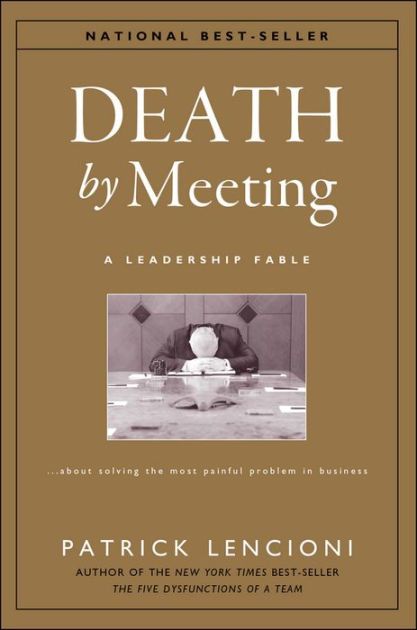Death by Meeting – Patrick M. Lencioni

We don’t like meetings, but they are important. Let’s make them purposeful, contextual and dramatic!
Don’t Avoid The Disagreements
When you avoid these disagreements and stifle debate, you bury resentment and frustration that will fester and manifest itself in other forms of unproductive personal conflict or politics.
You have deprived your team of the opportunity to actively engage in the meeting and work towards a better solution.
Meetings Are Boring And Ineffective
- Too many meetings are just plain boring. They’re tedious and uninspired.
- The leader is too focused on agendas and finishing on time to notice a lack of engagement.
- Most meetings have an aftertaste of being drained.
The Bottom Line
Meetings are the nexus of all business decisions and activities. We need to remember that meetings are human. They require a personal touch. Rigid rules and agendas will never solve our meeting dilemma. Reducing the amount of face to face communication only guarantees more confusion and lack of clarity.
It’s with the help of drama and context that leaders stand to reclaim a productive meeting culture.
Give Real-Time Permission
Sometimes the group in attendance will be reluctant to challenge each other in active debate. One tactic you can use to mine for conflict in this situation is to give real-time permission. At the start of the meeting, a leader may announce that the topic is expected to drive conflict, and that meeting members are encouraged to debate and challenge one another.
The Daily Five Minute Check-In
The daily check-in is a 5-minute standing meeting where the team gets together in the morning to clarify the actions they intend to take that day. It provides a forum for ensuring nothing falls through the cracks and the team is informed and aligned with what everyone else is doing. It will drastically reduce the number of superfluous emails between team members sent throughout the day
Meetings: The Necessary Evil
Upward to 30% of our time at work is spent in meetings.
Meetings are vitally important to the success of any organization. CEOs and their board of directors choose whether to expand into new markets or shut down a regional branch in meetings. Meetings are the lifeblood of every organization.
Yet the paradox of meetings is that we generally don’t like them. In fact, some of us despise them.
Allowing for Drama
We can sit at attention silently for hours in a dark theatre, but somehow can’t make it through a 30-minute project status meeting without checking our email. What’s the key difference? Drama.
Drama is the driving engine of every movie. Over the years, screenwriters have mastered the art of conflict to draw you in and keep you entertained.
Mine for Conflict
As a leader, you must have the courage to mine for conflict.
An intelligent group of diverse people will seldom agree on issues that matter. It’s natural and productive for disagreement to unfold. Working to resolve those differences and compromise on a unique solution is interesting, productive, and fun.
The Weekly Tactical
The Weekly Tactical is analogous to a weekly staff meeting, but the focus is more disciplined. The Weekly Tactical is focused exclusively on tactical issues of immediate concern.
The rules for the Weekly Tactical are as follows: Everyone always attends. It is facilitated with a sense of discipline and structural consistency.
The Three Components Of The Weekly Tactical Meeting
Lightning Round: A quick, around-the-table reporting session in which everyone communicates their two or three priorities of the week. Each person is given 60 seconds.
Progress Review: Next, the group should routinely review the reports on critical business information or metrics.
Real-Time Agenda: The agenda for a Weekly Tactical should NOT be set before the meeting, but only after the lightning round and progress review have taken place.
Context Matters
Without context, some team members will believe that the meeting should have been shorter and focused on tactical day-to-day issues, while others will be upset that the meeting didn’t allow enough time to have a thorough strategic discussion.
A meeting without contextual structure leaves a bad taste in everyone’s mouth. One generic meeting format is a surefire recipe for ineffective meetings.
We must be disciplined to structure our meetings with the purpose of catering to a specific business need.
The Monthly Strategic
It’s where the executive team grapples with complex and critical issues that will fundamentally influence the direction of the business.
The length of the Monthly Strategic will vary depending on the topics addressed. But the rule of thumb says that it will require at least two hours, and should not cover more than two topics.
This type of meeting requires a prepared agenda and upfront research or preparation by the team members. It is imperative that the leader mines for conflict in these meetings and that the team engages in constructive debate as they work to arrive at the best solution.
The Quarterly Offsite Review
An effective Quarterly Offsite Review is an opportunity for executives to step away from the immediate issues that normally command their attention, and allows them to review the business from a more holistic, long-term perspective.
In these offsite meetings, the team may review its strategic direction in light of its competition or industry trends.
Injecting Drama: The Hook
The hook is the first key to injecting drama into a meeting. As the leader of the meeting, it behooves you to ensure that you set up the meeting within the first 10 minutes such that your team understands and appreciates what is at stake.

